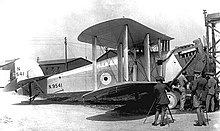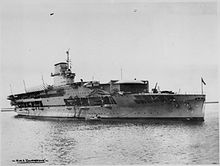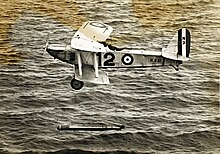Blackburn Darts
The Blackburn Dart was a single-engine, single-seat torpedo aircraft operated by the Royal Air Force for British aircraft carriers . The machine used by the carrier units from 1923 was in service until 1934.
The subsequent models Blackburn Ripon and Blackburn Baffin were further developments of the dart .
Development of the darts
The firm Blackburn Aircraft was the end of the First World War, only two prototypes of the type Blackburd built as a single-seat torpedo planes. In 1919, the company's chief designer, Major Frank Arnold Bumpus , designed a new aircraft that was named T.1 Swift . The large single-seat biplane had wings of the same span, which were connected by two pairs of struts and somewhat staggered. The middle section of the wings had a tubular steel construction, the other surfaces a wooden frame. The surfaces could be folded up on an aircraft carrier to park the machines. The wings, like the fuselage, were covered with fabric. The hull was attached to the lower surface and had a steel frame. All four wings had ailerons and the control surfaces at the stern were braced with wires. The landing gear wheels were attached to two individual struts, between which the torpedo was attached under the fuselage.
The machine was powered by a 450 hp Napier Lion IB engine that was installed slightly upwards in the fuselage. Below him was the radiator, which had a large front blind. The engine, designed as a W engine , had three exhaust pipes. The side outlets were led under the lower wings, while the middle tube, placed somewhat lower, led past the cockpit to the right of the fuselage.
The prototype Swift G-EAVN made its maiden flight in September 1920. Constructive deficiencies with regard to the center of gravity of the machine were eliminated by a slight inclination of the wings and a revised tail rudder. The Aviation Ministry eventually bought the machine and tested it thoroughly as the N139 from January 1921 . With small changes, three more prototypes were finally ordered under Specification 3/20 and then series production under the name Blackburn Dart Mk.II for the carrier use according to Specification 32/22 was agreed after the Ministry had initially considered the use as a land-based torpedo bomber ( 9/21 ) had given up again. During the development phase, the Blackburn company had already received orders for the machine, so that the export machines are usually referred to as Blackburn Swift , while the RAF machines were delivered as Blackburn Darts . The Navy Air Force , then still part of the Royal Air Force , received two versions:
- T.2 Dart Mk.II
- equipped with a 450 PS (336 kW) Napier Lion IIB or 465 PS Lion V, 114 of which were built, the last ten machines could be equipped with a float chassis
- T.2 Dart Mk.II trainer
- three two-seat training aircraft equipped with floats and 465 hp (347 kW) Lion V engines; from these the Blackburn T.3 Velos was developed, which could be sold to Greece.
Used by the British Fleet Air Force
On April 1, 1923, the Royal Air Force reorganized its units intended for naval combat. For the first time, special flights (swarm) were set up for the use of aircraft carriers. This also resulted in two “Fleet Torpedo” flights, both of which received six Blackburn Darts as operational aircraft.
The Flight 460 was intended for use on the HMS Eagle , the Flight 461 for the HMS Furious . Both girders were under renovation at this point in time. At the end of the year the Eagle came back into service and trained with the units assigned to it. At the beginning of June 1924 it began to be deployed in the Mediterranean Fleet with the largest air group previously deployed by an aircraft carrier. They had four flights of six machines: 402 with Fairey Flycatcher - fighter planes , 422 with Blackburn Blackburn and 440 with III Supermarine Seagull reconnaissance, and 460 with Blackburn Dart -Torpedoflugzeugen. One of the flights was usually not on board, but detached to one of the land bases Halfar on Malta or Aboukir near Alexandria . 460 remained in service with the Eagle in the Mediterranean and exchanged the dart in November 1930 for the successor Blackburn Ripon .
461 had to wait until April 1925 for its carrier. The converted Furious then began its tests as a large carrier without an island structure. The first night landing on an aircraft carrier took place on May 6, 1926, when Squadron Leader GH Boyce landed with his dart on the illuminated flight deck of the Furious off the Isle of Wight . Flight Lieutenant Boyce, the leader of Flight 462 , which had been set up as the second torpedo flight for the Furious in May 1924, landed after him . 462 was converted to the successor Blackburn Ripon in February 1929 as the first dart flight , 461 followed in December 1929.
On September 1, 1927, two more Fleet Torpedo Flights were set up with the Blackburn Dart , 463 and 464 , which were intended for the carrier HMS Courageous . This was put into service at the end of February 1928 after conversion and joined the Mediterranean fleet until 1930 and then switched to the Atlantic fleet. The two dart flights remained in service until April 1933 and were then merged into the 810 torpedo bomber squadron . This began in September with the conversion to the Blackburn Ripon . The last darts were not finally eliminated until the subsequent conversion to Blackburn Baffin in July 1934. This ended the Blackburn Dart's service in the squadrons after more than eleven years.
A Blackburn Dart was assigned to the RAF's 36th Squadron, which emerged from the "Coastal Defense Torpedo Flight" as the RAF's first land-based torpedo bomber squadron . Originally, the darts should only do support tasks. She was then used as an emergency machine alongside the Hawker Horsley of the squadron until the squadron was transferred to Singapore .
The three Blackburn Dart Mk.II float planes produced by Blackburn were intended as training aircraft for advanced training and were used in an RAF Reserve School on the Humber operated by Blackburn .
Assignments to other nations
The Blackburn Dart was probably only used as an operational aircraft in Greece, even if three other countries were supplied. In addition to the machines ordered by the RAF, Blackburn built another 17 machines, but these were called Swift and Velos .
- Swift Mk II
- early export version, first deliveries before the series machines for the RAF; seven machines were produced, which were delivered to the US Navy and the Japanese Navy (two each), and Spain received three more machines.
- Swift F
- Name of the United States Navy for the two Swift Mk.II purchased for comparison purposes . The US Navy decided to procure the two-seat Douglas DT-2 . In the event of a follow-up order, the Swift F BST-1 would have been designated.
- T.3 bikes
- Four two-seater machines for the Greek Navy with interchangeable landing gear, a movable MG in the rear cockpit and double steering . With the support of Blackburn, Greece built its own aircraft factory in Phaleron , which produced 12 other aircraft under license from 1925 onwards and also built other British types. The 16 machines remained in use until the mid-1930s.
- T.3A bikes
- Blackburn built six more machines of the two-seater type on his own account. A demonstration tour in South America in 1927 resulted in no orders. Machines used for various tests and in the aforementioned school.
Further developments from the darts
As early as 1922, the structure of the Dart was used for the newly developed prototype of a carrier-based reconnaissance aircraft . The machine with the idiosyncratic hull for three crew members was ordered by the RAF as Blackburn Blackburn and Blackburn manufactured over 60 machines in two versions.
The successor model of the Dart , the 92 Blackburn Ripon , produced from 1926 onwards , was actually just a revised and modernized two-seater version of the original model.
The Blackburn Baffin , which replaced it, was even closer to its predecessor, as it actually only differed from this model in the changes that were necessary due to the use of a radial engine as the engine. This closeness is also made clear by the fact that many Baffins (68) were created by rebuilding Ripons .
Technical specifications
| Parameter | T.1 Swift | T.2 Dart Mk.II | R-1 Blackburn Mk.I | T.3 Velos |
|---|---|---|---|---|
| crew | 1 | 3 | 2-3 | |
| length | 10.78 m | 11.02 m | 10.82 m | |
| span | 14.78 m | 13.86 m | 13.84 m | 14.78 m |
| height | 3.91 m | 3.81 m | 3.73 m | |
| Wing area | 60.8 m² | 60.4 m² | 60.76 m² | |
| Empty mass | 1610 kg | 1900 kg | 1786 kg | 1711 kg |
| Takeoff mass | 2858 kg | 3000 kg | 2710 kg max. 3022 kg |
2895 kg |
| Top speed | 182 km / h | 170 km / h | 157 km / h | 172 km / h |
| Range | 660 km | 4:15 h | ||
| Service ceiling | 4000 m | 3950 m | 4300 m | |
| drive | a Napier Lion IB, 450 hp | a Napier Lion IB, 450 hp or Napier Lion V, 465 hp |
a Napier Lion IB, 450 hp | |
| Armament | - | - | 2 MG | 1 MG |
| Bomb load | a torpedo | one torpedo or four bombs (946 kg) |
- | one torpedo or four bombs (416 kg) |
See also
literature
- David Brown: HMS Eagle , Warship Profile 35, 1973
- CA Jenkins: HMS Furious , Warship Profile 23/24, 1972
- Peter Lewis: The British Bomber since 1914 , Putnam London, 3rd edition 1980, ISBN 0-370-30265-6
- Kenneth Munson: Bomber 1919–1939 , Orell Füssli; Zurich, 1971
- Ray Sturtivant: The Squadrons of the Fleet Air Arm , Air-Britain Tonbridge, 1984, ISBN 0-85130-120-7
Web links
- Blackburn Swift
- Blackburn Darts
- Blackburn Velos
- Blackburn Swift (russ.)
- Blackburn Dart (Russian)
- Blackburn Velos (russ.)
- Blackburn Dart (Engl.)
- "The Blackburn Twin-Float Seaplane" . Flight , 7 May 1925, pp. 269-272.
- The "Velos" was the first airplane that was built under license in Greece (English)







